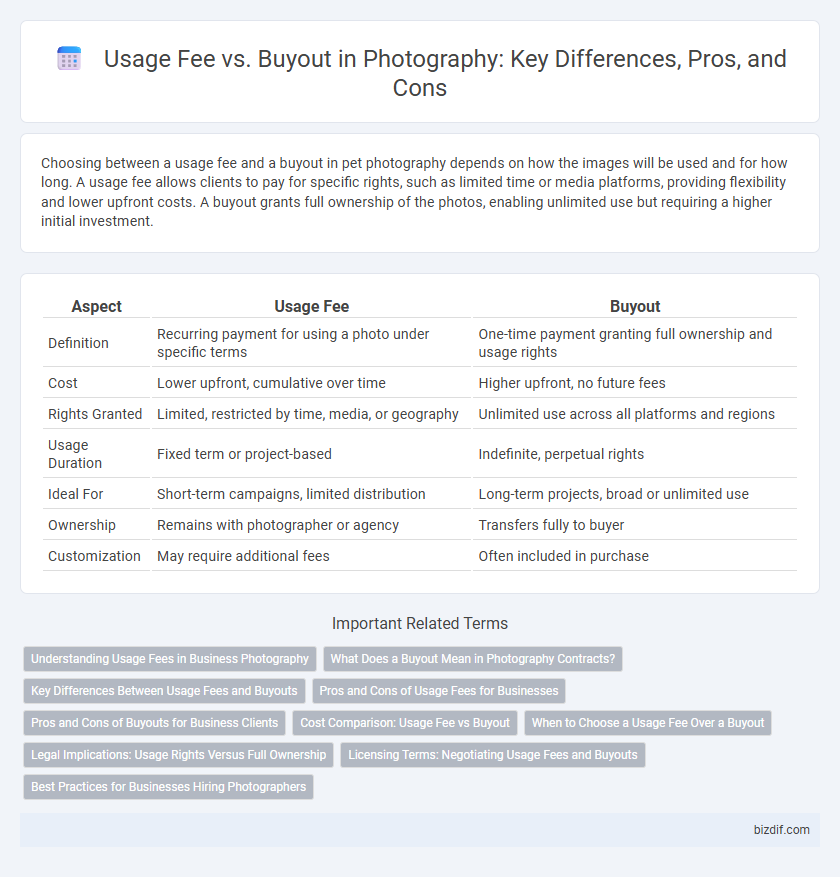Choosing between a usage fee and a buyout in pet photography depends on how the images will be used and for how long. A usage fee allows clients to pay for specific rights, such as limited time or media platforms, providing flexibility and lower upfront costs. A buyout grants full ownership of the photos, enabling unlimited use but requiring a higher initial investment.
Table of Comparison
| Aspect | Usage Fee | Buyout |
|---|---|---|
| Definition | Recurring payment for using a photo under specific terms | One-time payment granting full ownership and usage rights |
| Cost | Lower upfront, cumulative over time | Higher upfront, no future fees |
| Rights Granted | Limited, restricted by time, media, or geography | Unlimited use across all platforms and regions |
| Usage Duration | Fixed term or project-based | Indefinite, perpetual rights |
| Ideal For | Short-term campaigns, limited distribution | Long-term projects, broad or unlimited use |
| Ownership | Remains with photographer or agency | Transfers fully to buyer |
| Customization | May require additional fees | Often included in purchase |
Understanding Usage Fees in Business Photography
Usage fees in business photography refer to the charges paid for the specific rights to use images within defined parameters such as duration, geographic region, and media type. These fees are essential for businesses seeking flexible licensing options without purchasing full ownership of the photographs. Understanding usage fees helps clients negotiate appropriate terms and avoid unexpected costs linked to extended or expanded image usage.
What Does a Buyout Mean in Photography Contracts?
A buyout in photography contracts grants the client full rights to the images, allowing unlimited use without additional fees, unlike a standard usage fee which typically limits the scope, duration, or medium of use. Photographers often negotiate buyouts to ensure exclusive control transfers, eliminating future licensing concerns or royalties. Understanding buyout terms is crucial for both parties to clarify ownership, usage boundaries, and payment obligations in professional photo agreements.
Key Differences Between Usage Fees and Buyouts
Usage fees in photography are charged based on specific parameters such as duration, media type, and geographic region, allowing clients to license images for limited use without full ownership. Buyouts, on the other hand, grant clients complete ownership and unlimited use rights of the photographs, typically involving a higher upfront cost. Key differences include the scope of usage rights, cost structure, and control over future use and distribution of the images.
Pros and Cons of Usage Fees for Businesses
Usage fees allow businesses to pay for specific rights to use photographic content within defined parameters, aiding budget control and flexibility in marketing campaigns. However, recurring fees can accumulate over time, leading to higher long-term costs compared to buyout models. Limited usage rights may restrict businesses from leveraging images across diverse channels, potentially hindering brand consistency and expansion.
Pros and Cons of Buyouts for Business Clients
Buyouts offer business clients full ownership and unlimited usage rights of photographic content, eliminating future licensing fees and simplifying legal concerns. This approach ensures long-term cost efficiency and flexibility for marketing campaigns but requires a higher upfront investment compared to standard usage fees. However, the lack of recurring revenue for photographers may limit ongoing income streams and can reduce negotiation leverage for future projects.
Cost Comparison: Usage Fee vs Buyout
Usage fees for photography typically involve paying based on the specific duration, medium, or geographic scope, making them cost-effective for short-term or limited use projects. Buyouts require a one-time, often higher upfront payment, granting unlimited usage rights and eliminating future fees, which is economical for extensive or long-term usage. Comparing costs, usage fees may accumulate to surpass buyout costs over time, especially for heavily distributed or perpetual campaigns.
When to Choose a Usage Fee Over a Buyout
Choosing a usage fee over a buyout is ideal when the photographer or client anticipates multiple or long-term uses of the images, allowing for flexible licensing based on specific usage periods or platforms. Usage fees are preferable for projects where image distribution may change across media, regions, or campaigns, enabling cost control and rights management aligned with actual application. This approach benefits both parties by ensuring fair compensation without relinquishing full ownership, maintaining future revenue opportunities and creative control.
Legal Implications: Usage Rights Versus Full Ownership
Usage fees grant photographers limited rights to use their images within specific parameters, preserving the original copyright and restricting client use to defined contexts. Buyouts transfer full ownership and all associated rights to the client, allowing unrestricted usage but requiring clear contractual terms to prevent future disputes. Understanding these legal distinctions is essential to protect intellectual property and ensure proper compensation in commercial photography agreements.
Licensing Terms: Negotiating Usage Fees and Buyouts
Negotiating usage fees involves defining specific rights for limited use, such as duration, territory, and media, allowing photographers to retain ownership while earning recurring income. Buyouts transfer full ownership of the image to the client, often involving a one-time, higher payment that relinquishes the photographer's future claims. Clear licensing terms ensure both parties understand usage scope, minimizing disputes and maximizing fair compensation for commercial or editorial applications.
Best Practices for Businesses Hiring Photographers
Businesses hiring photographers should clearly define usage fees versus buyout options to avoid legal complications and budget overruns. Usage fees cover limited rights based on specific terms such as duration, medium, and geographic location, while buyouts grant broader or exclusive rights for indefinite use. Incorporating detailed usage agreements tailored to the project scope ensures transparent pricing and protects both parties' interests.
Usage Fee vs Buyout Infographic

 bizdif.com
bizdif.com